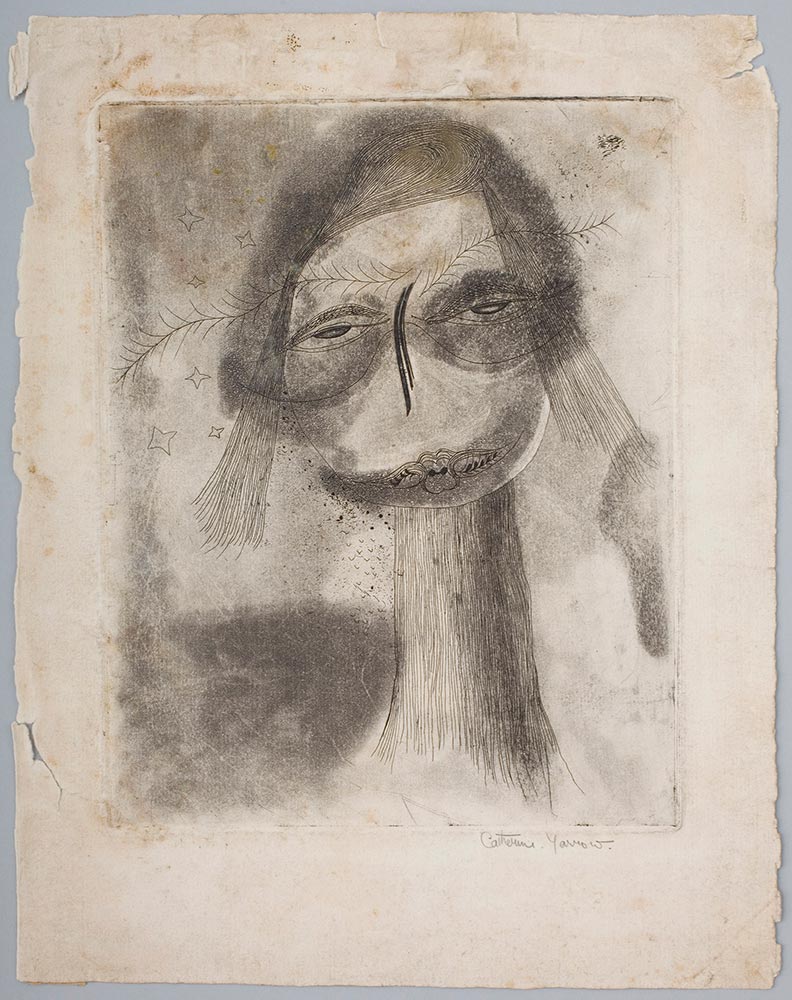96. Catherine Yarrow
| Life Dates | 1904-1990 |
| Place of Birth | Harpenden, England |
| Birth Name | Catherine Yarrow |
British-born Catherine Yarrow was active during Atelier 17’s initial years in Paris and after its move to New York.1 During her twenties, Yarrow moved peripatetically and was living, at times, in London, Paris, Italy, and Spain, and making an around-the-world trip with her mother. By the late 1920s, Yarrow had settled in Paris where she befriended many of the Surrealists, including Alberto Giacometti. In addition to studying with the Spanish ceramic artist Josep Llorens i Artigas, Yarrow also experimented with printmaking at Atelier 17. Although she did not participate in any of Atelier 17’s group exhibitions during the studio’s time in Paris, there are many extant prints from the 1930s, including Not What I Want (1935) and Head with Stars (1935).2 She fled Paris in 1940 with the Nazi’s invasion, and ended up in New York by 1941 where she reconnected with the network of Surrealist artists, who now congregated around the New School for Social Research. She was close friends, for a time, with fellow Atelier 17 participant Louise Bourgeois, who immortalized their falling-out in her sculpture Portrait of C.Y. (1947-8, National Gallery of Canada).3 Yarrow made a few prints at Atelier 17 during the early 1940s, one of which titled Three Witches (1944) she exhibited with the Atelier 17 group at the Willard Gallery (1945). Another print from her time in Paris, titled Head (1936), was exhibited in New Directions in Gravure (1944) at the Museum of Modern Art. Unfortunately, most of Yarrow’s prints from the 1940s were lost in an apartment fire in December 1945.4 The artist ultimately returned to Europe in 1948, where she established a studio in London and continued to produce ceramics until her death in 1990. Yarrow also made monoprints during the 1950s, showing the lasting influence of Atelier 17.
Notes
- The website established by Mary Ann Ephgrave, executor of Yarrow’s estate, contains excellent information about the artist. Accessed November 9, 2018: http://www.catherineyarrow.com. ↩
- Stanley William Hayter preserved an impression of Not What I Want in his personal collection. The catalogue from a 2012 exhibition of Yarrow’s work contains numerous other examples of her prints from the 1930s. Piers Worth, Not What I Want (London: Austin/Desmond Fine Art, 2012). ↩
- The appendix in the Austin/Desmond Fine Art’s 2012 catalogue provides more context for the relationship between Yarrow and Bourgeois. See Worth, 60–62. ↩
- Mary Ann Ephgrave, executor of Catherine Yarrow’s estate, to Christina Weyl, October 26, 2012. ↩


